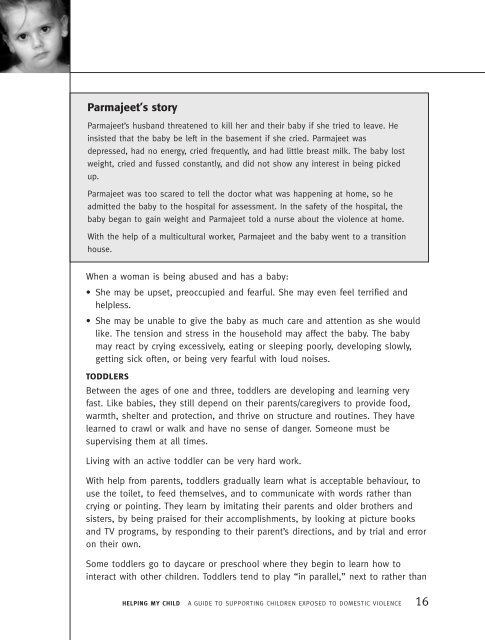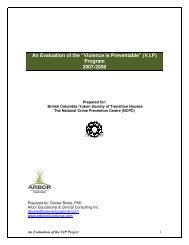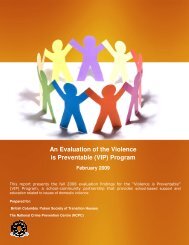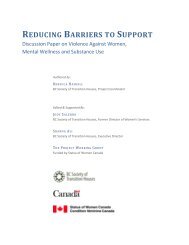a guide to supporting children exposed to domestic violence
a guide to supporting children exposed to domestic violence
a guide to supporting children exposed to domestic violence
Create successful ePaper yourself
Turn your PDF publications into a flip-book with our unique Google optimized e-Paper software.
Parmajeet’s s<strong>to</strong>ry<br />
Parmajeet’s husband threatened <strong>to</strong> kill her and their baby if she tried <strong>to</strong> leave. He<br />
insisted that the baby be left in the basement if she cried. Parmajeet was<br />
depressed, had no energy, cried frequently, and had little breast milk. The baby lost<br />
weight, cried and fussed constantly, and did not show any interest in being picked<br />
up.<br />
Parmajeet was <strong>to</strong>o scared <strong>to</strong> tell the doc<strong>to</strong>r what was happening at home, so he<br />
admitted the baby <strong>to</strong> the hospital for assessment. In the safety of the hospital, the<br />
baby began <strong>to</strong> gain weight and Parmajeet <strong>to</strong>ld a nurse about the <strong>violence</strong> at home.<br />
With the help of a multicultural worker, Parmajeet and the baby went <strong>to</strong> a transition<br />
house.<br />
When a woman is being abused and has a baby:<br />
• She may be upset, preoccupied and fearful. She may even feel terrified and<br />
helpless.<br />
• She may be unable <strong>to</strong> give the baby as much care and attention as she would<br />
like. The tension and stress in the household may affect the baby. The baby<br />
may react by crying excessively, eating or sleeping poorly, developing slowly,<br />
getting sick often, or being very fearful with loud noises.<br />
TODDLERS<br />
Between the ages of one and three, <strong>to</strong>ddlers are developing and learning very<br />
fast. Like babies, they still depend on their parents/caregivers <strong>to</strong> provide food,<br />
warmth, shelter and protection, and thrive on structure and routines. They have<br />
learned <strong>to</strong> crawl or walk and have no sense of danger. Someone must be<br />
supervising them at all times.<br />
Living with an active <strong>to</strong>ddler can be very hard work.<br />
With help from parents, <strong>to</strong>ddlers gradually learn what is acceptable behaviour, <strong>to</strong><br />
use the <strong>to</strong>ilet, <strong>to</strong> feed themselves, and <strong>to</strong> communicate with words rather than<br />
crying or pointing. They learn by imitating their parents and older brothers and<br />
sisters, by being praised for their accomplishments, by looking at picture books<br />
and TV programs, by responding <strong>to</strong> their parent’s directions, and by trial and error<br />
on their own.<br />
Some <strong>to</strong>ddlers go <strong>to</strong> daycare or preschool where they begin <strong>to</strong> learn how <strong>to</strong><br />
interact with other <strong>children</strong>. Toddlers tend <strong>to</strong> play “in parallel,” next <strong>to</strong> rather than<br />
HELPING MY CHILD A GUIDE TO SUPPORTING CHILDREN EXPOSED TO DOMESTIC VIOLENCE 16






